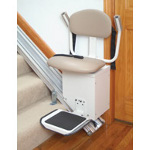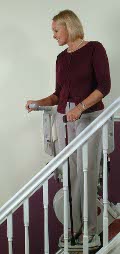Promoting Elderly Staircase Accessibility
Published by Stephen on September 24, 2009 Under stair liftsOne of the leading factors that can affect the life of a senior with arthritis is the ability to safely use the stairs. In fact, the stairs are so dangerous to the elderly that falls on the stairs account for the most hospitalizations and accidental deaths among those over 65.
There are a number of things that lead to these accidents on the stairs and although arthritis is a leading cause, there are a number of other conditions that are more common among the elderly and contribute to falls on the stairs.
There are several ways that using the stairs can be made safe for the elderly, with some choosing to move to a nursing home, avoid the stairs, or rely on a helping hand from friends and family. Unfortunately, each of these approaches can, in some cases, have a very negative impact on ones life.
Stair lifts, on the other hand, provide an inexpensive and easy way to make the stairs safer, without having to make a major life change. This is one of the reasons this type of home medical equipment has become so popular over the last ten years.
What Are Stair Lifts?
 Stair lifts, while having first been developed in the early 1920′s, did not become commonplace until the 1990′s. It was then that several easy to install and comparatively inexpensive stair lift models were developed. Today, almost twenty years later, the stair lift has advanced technologically and is much more reliable, durable, and dependable.
Stair lifts, while having first been developed in the early 1920′s, did not become commonplace until the 1990′s. It was then that several easy to install and comparatively inexpensive stair lift models were developed. Today, almost twenty years later, the stair lift has advanced technologically and is much more reliable, durable, and dependable.
The Stair Lift is designed to move a person up or down the stairs, moving along the length of the staircase. Most provide a chair for the user to sit in as they move up or down the staircase, which is why these devices are often called stair chairs.
The chair is attached to a metal track, which for most stairways can be attached to the steps of the staircase. However, if the staircase is curved or very narrow, it may be necessary to attach the stair lift track to the wall instead. In these cases, a professional installation will likely be needed, but for most other staircases, the homeowner can easily install the stair lift on their own.
Sitting Stairlifts vs Standing Stairlifts
 For most seniors and others who are unable to safely use the stairs, a stair chair is the best type of stair lift to use. This is because the user remains in a seated position as the lift moves up the staircase, so there is little risk of a fall. Many also come with seat belts and offer chest restraints, which can provide an extra sense of security when using the stair lift. The chair also is mounted on a pivot, so it can be swiveled away from the staircase when entering and exiting the stair lift.
For most seniors and others who are unable to safely use the stairs, a stair chair is the best type of stair lift to use. This is because the user remains in a seated position as the lift moves up the staircase, so there is little risk of a fall. Many also come with seat belts and offer chest restraints, which can provide an extra sense of security when using the stair lift. The chair also is mounted on a pivot, so it can be swiveled away from the staircase when entering and exiting the stair lift.
There are some people, however, that are not capable of bending their knee or hip enough to safely sit down in a standard stair lift, which is most common among those who have had a knee or hip replacement surgery. In these situations, it might not be possible to safely or comfortably use a stair chair, so a standing stair lift is also available.
These devices, which are called perch lifts, provide an area that the user can stand on as they are carried up the stairway. Some perch lifts also offer a waist high support that can be leaned against as the lift moves along the staircase. Since there is an increased risk of a fall when using a perch lift, they should only be used if it is medically necessary.
No Comments |
Add a Comment